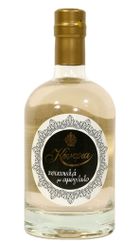Tsikoudia: Difference between revisions
Uncle Jesse (talk | contribs) (Adding image) |
Uncle Jesse (talk | contribs) No edit summary |
||
| Line 4: | Line 4: | ||
Fire water, or Tsikoudia, was probably made by the Minoans because evidence points to the [[distillation]] of [[wine]] [[spirits]] around Middle Minoan II, c. 1900-1700 B.C. | Fire water, or Tsikoudia, was probably made by the Minoans because evidence points to the [[distillation]] of [[wine]] [[spirits]] around Middle Minoan II, c. 1900-1700 B.C. | ||
In order to create tsikoudia, a strong [[ | In order to create tsikoudia, a strong [[alcoholic beverage]] consumed at Crete, there must be a [[fermentation]] and distillation process. The discovery of a number of pithoi that had carbonized remains of [[grape]]s and grape pits shows that the Minoan makers knew a process of fermentation/distillation even though the technique of distillation "presupposes expert knowledge and special vessels" (Prof. Athanasia Kanta, University of Rethymnon, Crete). However, the technique of production was similar with traditional methods used today. | ||
Making it without the modern day tools proved that it was still possible: | Making it without the modern day tools proved that it was still possible: | ||
Revision as of 23:06, 7 October 2017
A Greek liqueur.
Fire water, or Tsikoudia, was probably made by the Minoans because evidence points to the distillation of wine spirits around Middle Minoan II, c. 1900-1700 B.C.
In order to create tsikoudia, a strong alcoholic beverage consumed at Crete, there must be a fermentation and distillation process. The discovery of a number of pithoi that had carbonized remains of grapes and grape pits shows that the Minoan makers knew a process of fermentation/distillation even though the technique of distillation "presupposes expert knowledge and special vessels" (Prof. Athanasia Kanta, University of Rethymnon, Crete). However, the technique of production was similar with traditional methods used today.
Making it without the modern day tools proved that it was still possible:
"The remains of the trodden grapes, together with the stalks and pits, were placed in a large pithos similar to Minoan vessel and left for about two weeks, according to a practice with striking similarities to the Minoan, to allow fermentation to take place. They were then sealed in a bronze cooking pot. A second, empty vase was placed inside the first, and the pot was closed with a lid and sealed with dough/yeast to prevent the vapour from escaping. The pot was then placed on a slow fire, and the lid was cooled continuously with a piece of cloth dipped in cold water. When the vapour from the grapes/pits rose to the lid, it condensed and fell into the smaller vessel. The experiment produced tsikoudia of good quality." --Prof. Athanasia Kanta
